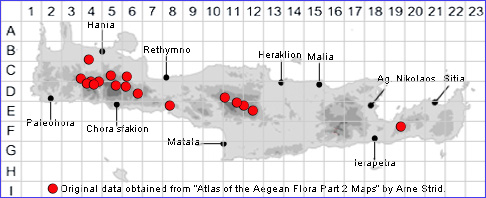SPECIES DESCRIPTION
SIDERITIS SYRIACA subsp. SYRIACA
Family and Genus:- See- LABIATAE/Sect. EMPEDOCLIA
Common Names:- Malotira
Homotypic Synonyms:- None
Meaning:- Sideritis (Gr) The Greek name, ''sideritos'', for plants used on wounds
caused by iron weapons.
Syriaca (L) From Syria, Syrian.
General description:- Grey- or white- long lanate, perennial.
Stems:-
1) 10-50 cm.
Leaves:-
1) Lower, 10-60 x (5-)6-20 mm, oblong to narrowly obovate, entire, crenulate or
denticulate.
2) Middle and upper, up to 80 x 18 mm, linear-lanceolate or oblong, entire.
Flowers:-
1) Verticillasters, 5-20, 6- to 10-flowered, mostly distant, rarely all crowded.
2) Most bracts, broadly ovate to suborbicular with a distinct acumen or cusp.
3) Middle bracts, 6-12 mm (including acumen), usually shorter than or equalling the
flowers, suborbicular, acumen 2-3 mm.
4) Calyx, 7-12 mm;
a) teeth, 2·5-5 mm, half as long to almost as long as the tube.
5) Corolla, 9-15 mm, yellow.
Key features:-
1) Most bracts, broadly ovate to suborbicular with a distinct acumen or cusp.
2) Middle bracts, usually equalling or shorter than the flowers and often shorter than
the calyx.
3) Calyx, 7-12 mm.
4) Corolla, (9-)10-15 mm.
5) Verticillasters, usually distant.
Habitat:- Rocky limestone slopes and screes, rock ledges, dolines. 1000-2200 m.
Distribution:- A Cretan endemic, most frequent in the Lefka Ori and Psiloritis with
one location in Afendis Kavousi area.
Flowering time:- June- July.
Photos by:- Fotis Samaritakis

